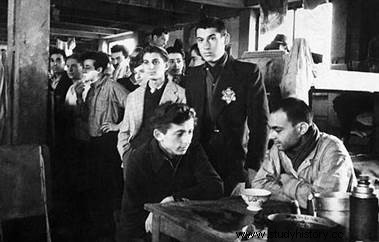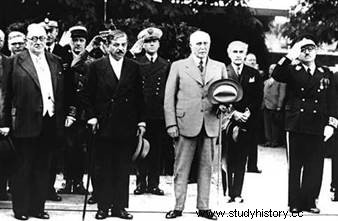 16 and 17 July 1942 , during the Vel d'Hiv roundup , the French police proceeded to the mass arrest of thousands of Jews, on the orders of the Vichy government. Men, women and children were soon brought back to the Vélodrome d'Hiver in Paris, place of the beginning. Not the beginning of a life, but rather the beginning of a death. It was not until 1995 and a speech by President Jacques Chirac that the taint represented by these black hours in the history of France was recognized.
16 and 17 July 1942 , during the Vel d'Hiv roundup , the French police proceeded to the mass arrest of thousands of Jews, on the orders of the Vichy government. Men, women and children were soon brought back to the Vélodrome d'Hiver in Paris, place of the beginning. Not the beginning of a life, but rather the beginning of a death. It was not until 1995 and a speech by President Jacques Chirac that the taint represented by these black hours in the history of France was recognized.
The modification of the balance of power and the return of Laval
While the Axis still suffered only limited and few setbacks, the balance of power nevertheless tended to evolve. Since June 1941, Hitler had been de facto bogged down, as part of Operation Barbarossa , in the USSR where he encountered strong resistance from the people practicing in particular the scorched earth policy. Moreover, the United States had entered the war against the Axis forces after the attack on Pearl Harbor (December 7, 1941) and at the same time, the resistance continued to grow around the person of General de Gaulle and had his first successes (Bir Hakeim).
 This is why Hitler, since December 1941, had been convinced of the importance of setting up of a final solution, aimed at annihilating the "Jewish race" (Mein Kampf), for which he harbored immeasurable hatred. Also the collaboration increased considerably after the return of Pierre Laval (1) who received the title of “head of government” and employed all his zeal in State collaboration. Deeming Xavier Vallat, Commissioner General for Jewish Affairs, too inactive, he had him replaced by an even more anti-Semitic man, Louis Darquier de Pellepoix, whose inclination for the Nazis was then beyond doubt.
This is why Hitler, since December 1941, had been convinced of the importance of setting up of a final solution, aimed at annihilating the "Jewish race" (Mein Kampf), for which he harbored immeasurable hatred. Also the collaboration increased considerably after the return of Pierre Laval (1) who received the title of “head of government” and employed all his zeal in State collaboration. Deeming Xavier Vallat, Commissioner General for Jewish Affairs, too inactive, he had him replaced by an even more anti-Semitic man, Louis Darquier de Pellepoix, whose inclination for the Nazis was then beyond doubt.
The Vel' d'Hiv roundup (July 16-17, 1942)
In July, the Vichy collaborationism of Philippe Pétain manifested itself in a crackdown on foreigners. The general secretary of the Vichy police, René Bousquet, agreed to hand over foreign Jews from the occupied zone to the Germans. On July 16, the mass arrest of these Jews began in Paris. This operation, called “spring wind”, concerns the districts of Paris where a large Jewish community lives (3rd, 10th, 11th, 12th arrondissements). It was prepared by the newly appointed Commissioner for Jewish Affairs, Darquier de Pellepoix. 900 teams are formed to carry out the arrests. 12,884 people, men and women (including 4,115 children), out of a total of 28,000 planned, were thus arrested by nearly 9,000 French police officers and brought to the Vélodrome d'Hiver, in the 15th arrondissement, while waiting to be interned in the Drancy camp for the majority, in the Paris region or even in Beaune-la-Rolande.
It was in deplorable conditions that those who had been confined there lived here for five days. The parents were forced to leave first, leaving distraught children, left to their own devices, who soon left in turn:in total, a third of the people who set foot on the ground of the Vél d'Hiv found themselves in fine in Auschwitz-Birkenau, Silesia (2).
The aftermath of the Vel d'Hiv roundup
That was just the prelude to the deportation of several other tens of thousands of Jews. The culmination of the collaboration, the Vel'd'Hiv roundup is only one episode:roundups have followed one another since 1941, strongly desired by Dannecker (SS representative in Paris) and the other Nazi leaders. Transit camps were organized everywhere in France (Drancy, Pithiviers, Beaune-la-Rolande for example) from which, from the spring of 1942, the death trains left for the concentration camps. The French authorities delivered to the Nazis the Jewish elites (Léon Blum, Georges Mandel) by the hundreds from 1941, the anti-Jewish laws of Vichy having preceded the Nazi wishes. After the Vel'd'Hiv roundup, other interventions took place throughout France, with Pierre Laval offering his assistance for operations carried out in the free zone.
 In total, it is estimated that around 80,000 Jews from France died in the Nazi extermination camps, i.e. 20 % of the Jewish population living in France in 1939 (3). Faced with this racist and collaborationist policy of the French State, some were quick to protest and to slay State anti-Semitism, like the Archbishop of Toulouse, Mgr Saliège, first of all a marshalist, who deplored that "children, women, men, fathers and mothers are treated like a vile herd, that the members of the same family are separated from each other and embarked for an unknown destination" (And clamor Jerusalem ascendit) or even Cardinal Gerlier in Lyon and Mgr Théas in Montauban. The roundups, quantitatively less significant, nevertheless continued:for the year 1942 alone, 42,600 Jews thus left France for the camps in Central Europe.
In total, it is estimated that around 80,000 Jews from France died in the Nazi extermination camps, i.e. 20 % of the Jewish population living in France in 1939 (3). Faced with this racist and collaborationist policy of the French State, some were quick to protest and to slay State anti-Semitism, like the Archbishop of Toulouse, Mgr Saliège, first of all a marshalist, who deplored that "children, women, men, fathers and mothers are treated like a vile herd, that the members of the same family are separated from each other and embarked for an unknown destination" (And clamor Jerusalem ascendit) or even Cardinal Gerlier in Lyon and Mgr Théas in Montauban. The roundups, quantitatively less significant, nevertheless continued:for the year 1942 alone, 42,600 Jews thus left France for the camps in Central Europe.
Since 1993, July 16 has become a national day in honor of victims of anti-Semitic persecution committed under the responsibility of Vichy. On July 16, 1995, President Jacques Chirac recognizes in a speech the responsibility of the French State in the policy of persecution of the Jews carried out in collaboration with Nazi Germany during the Second World War.
(1):Laval had been ousted from power on December 13, 1940, not only because his power was rising and could diminish that of the Marshal, but also because Weygand opposed this state collaboration that Laval wanted to put in place.
(2):A very large majority of those rounded up died in Auschwitz.
(3):It is generally considered that between 300,000 and 350,000 Jews lived in France at this date.
Non-exhaustive bibliography
- La Grande Rafle du Vel d'Hiv:July 16, 1942 by Claude Lévy. Text, 2004.
- Vichy France, 1940-1944 by Robert O. Paxton. History Points, 1999.
To go further
- The Roundup. Fiction by Rose Bosch, 2010. On DVD and BR.
